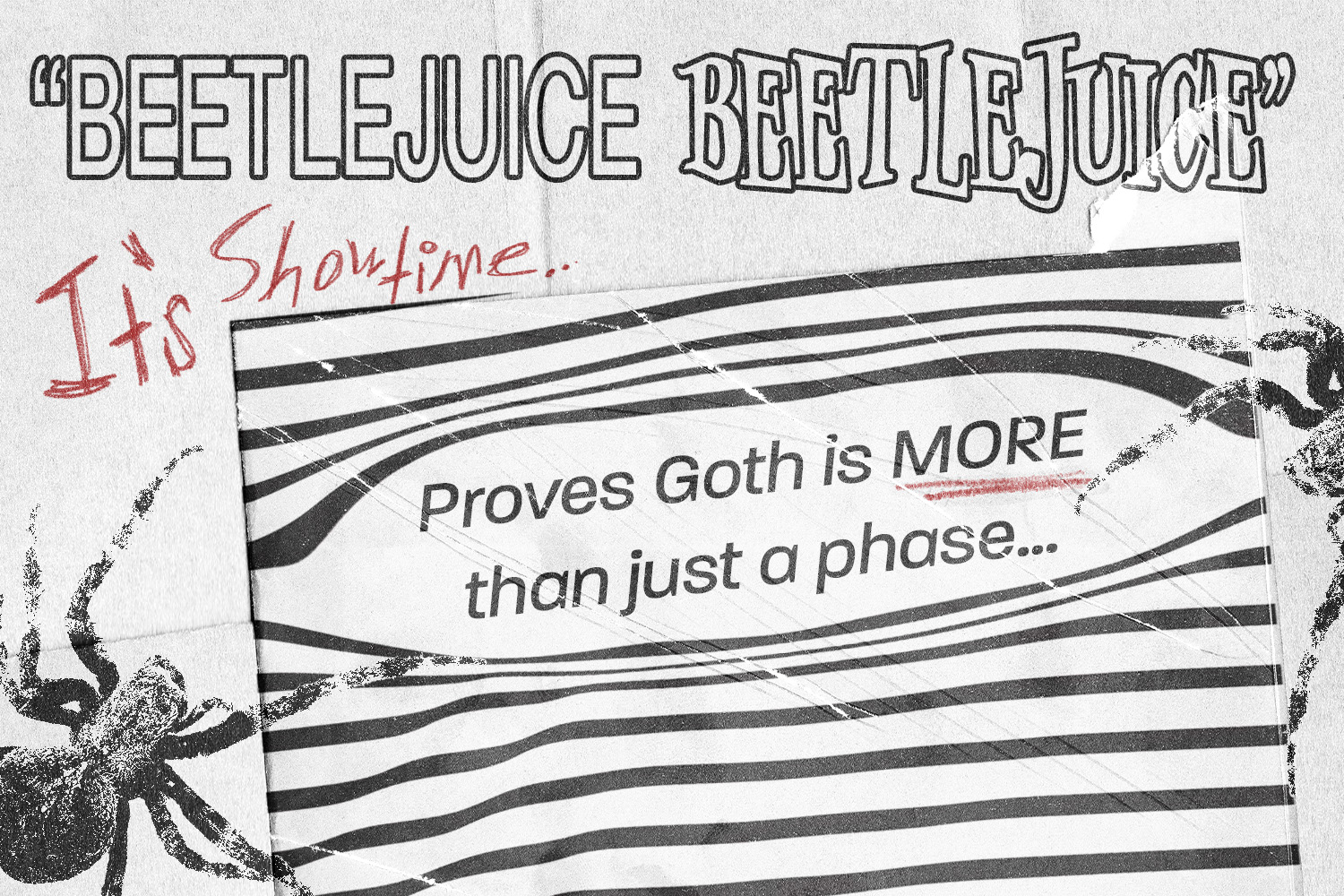With a different vocabulary entering the fashion sphere every couple of weeks, words like “brat” and “demure” influence the aesthetics of our wardrobe. This summer served up pops of loud greens with a side of butter yellow, but something darker and sexier is brewing this fall–and just in time for the SCAD Savannah Film Festival. From the shadows, goth fashion has emerged in this season’s colors and textures, imbued with the whimsical trademarks of director Tim Burton and his long list of eccentric characters.
The newest installment in Burton’s filmography, “Beetlejuice Beetlejuice,” (sequel to his 1988 horror-comedy, “Beetlejuice”) revives the moody and macabre and reopens the door to the land of the dead. Stuck in the Neitherworld, 50-year-old Lydia Deetz (Winona Ryder) and her daughter, Astrid Deetz (Jenna Ortega), face ghoulish challenges, while Catherine O’Hara’s Delia Deetz continues to experiment with obscure art, and Michael Keaton returns as the raunchy, no good, bio-exorcist demon, Betelgeuse.
Certain aspects of Burton’s films—deserted graveyards and toothy monsters—considered creepy or nightmarish, actually emphasize the beauty in the morbid. Burton, who spent his childhood wandering among tombstones, views them as a natural juxtaposition of life and death, much like the interplay between ghosts and humans in the “Beetlejuice” franchise. “It has a positive sense to it,” Burton explained to Interview Magazine, revealing how his films are more morbid celebration than fright. This is also true of the Gothic genre his films fall under. Burton’s “Edward Scissorhands” (1990), “The Nightmare Before Christmas” (1993), and “Corpse Bride” (2005) allow audiences to explore intense emotions, fantasies, and thrills without the constraints of rationality. In the original “Beetlejuice,” Lydia delves into these complexities as a young goth.
Goth fashion, however, finds its roots in Britain’s youth, where it sprang to life from the post-punk music scene in the late 1970s. Leather, fishnets, and piercings became a way for people back then to embrace the uncertainties of their time. Similarly, Lydia, who grapples with isolation and harmful ideations in the original “Beetlejuice,” dons an exclusively black wardrobe to represent the big, dark room that is her life. Black, lace veils shield Lydia’s pale complexion as she eats Cantonese takeout with her family. Her sulky eyes, spiky bangs, and sickly makeup bring the aesthetic together.
Goth is also about theatrics. Its penchant for exaggerated features and unconventional silhouettes is inspired by glam. A striking interpretation of goth-glam in “Beetlejuice” is the red wedding dress Lydia is forced to wear near the end of the film. Her gown symbolizes the struggle between good and evil, acceptance and sacrifice. Its voluminous, scarlet tulle echoes the Victorian saying, “Marry in red, better off dead,” as Lydia must either choose to marry Betelgeuse or lose her home, her parents, and the ghostly couple that she’s begun to call family.
On top of Lydia’s iconic wedding dress, “Beetlejuice Beetlejuice” is infused with a number of fashion references from the first film. The costumes maintain 80s undertones—denim jackets and cinched waists—but are reimagined to fit today’s audience. Lydia, now a grown woman and the host of a paranormal TV series, has shed the dramatics of her teen years, no longer sporting oversized, black brim hats at midnight. Though, her evolved wardrobe still reflects the brooding elements that once defined her teenage years. “Beetlejuice Beetlejuice” costume designer, Colleen Atwood, curates a more mature, sophisticated version of Lydia’s gothic style in the sequel. Lydia’s tailored blazers and long skirts mirror feminine icons of campy horror’s past, such as Elvira from the 80s horror-comedy “Mistress of the Dark.”
In “Beetlejuice Beetlejuice,” Lydia’s essence—the oddity, the defiance of convention—remains intact, making audiences question if goth was really ever just a phase. For Lydia, it’s not something that fades away with age but deepens into an elegant, self-assured expression of who she has always been. The resurgence of gothic, Victorian wardrobe brings with it a sense of belonging for women who have always felt like outsiders. Those who, like Lydia, declare, “I myself am strange and unusual.”
Parents are usually the ones wary of their children embracing the goth lifestyle, but “Beetlejuice Beetlejuice” flips the typical narrative on its head. Lydia, once the quintessential strange and unusual teen, finds discomfort in her own teenage daughter, Astrid, whose rebellious, anti-establishment energy is captured in shredded knits and combat boots. She opposes her mother’s traditional gothic sensitivities with intentional bursts of color—purple hues and daisy prints. But beneath the melancholy is a girl scared to be herself. In one scene, Lydia and Astrid wear similar plaid patterns. Atwood says the parallel plays on that idea that both “don’t want to be connected, but they are and they don’t even know it.”
Together, Lydia and Astrid represent two generations of goth women. They serve as mirrors to each other, reflecting the complexities of identity across different eras. Astrid echoes the same struggles Lydia faced in the first film, where she strives for individuality while navigating the shadows of familial ties. Their dynamic illustrates that while rebellion is often a part of growing up, being true to oneself does not mean abandoning one’s roots. Lydia and Astrid remind women afraid to be themselves that smudged, charcoal eyeliner and chokers are never just a phase—they are statements of individuality, symbols of authenticity, and proof that who you are at your core is never a trend.
Words by Natalia Hilsaca
Graphic by Juan Cruz

